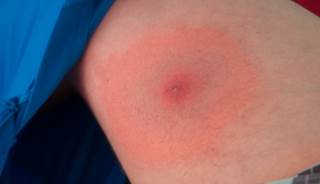From The Clinical Advisor
Audrey Marie Imhof, MSN, RN, CPN
This article is incomplete, and is based on CDC publication (2015) and Dr Wormser, et al study from 2006. Notice that near the end of the full article, the author advises doctors to tell their patients that since it takes weeks for antibodies to appear after a bite, not to bother with Lyme disease blood testing. While this is true about the antibody delay, many cautious LLMDs will treat with at least 14 days of Doxycycline just to be on the safe side. Dissemination of Lyme (and coinfections) can into the body can occur rapidly. I think patients should be advised of the controversy over Lyme detection and treatment options and be allowed to chose the treatment standard of care they prefer -- CDC/IDSA or ILADS.
This approach of trying to protect the patient reminds me of the debate over so-called silver (amalgam that includes mercury) tooth fillings vs composite (plastic/ceramic) fillings. Some states require the dentist to offer or at least disclose the patient on the existence of options. Some states prevent any disclosure about potential for mercury toxicity.
What makes more sense to you? Suppression of information in order to not confuse the patient, or giving them the benefit of the doubt that they are intelligent enough to make an intelligent choice? I think the medical establish had better wake up to the fact that the Internet is not going away anytime soon. I know *I* look up just about everything I am curious about, using a search engine. Patients are going to feel better about a doctor if they are made aware of controversy over a diagnosis and treatment plan, just as would be done in the case of, say, cancer treatment trials.
- Bob
Many providers incorrectly assume that patients, especially those living in high-risk areas, are familiar with Lyme disease and its attendant symptoms. Recently, I had a patient tell me that she was tested for Lyme disease after being bitten by an unknown insect. When asked if she had experienced symptoms of Lyme disease, she replied, "I don't even know what the symptoms are."
This was not an isolated incident, as I have been questioned by many people about Lyme disease. I have had people tell me that they do not know what a tick looks like. Others ask how to identify the classic "bull's-eye" rash, since many people have false ideas about the presentation of erythema migrans. I have been asked about vague symptoms that people have experienced, as well as what symptoms are associated with Lyme disease. Patients have also asked whether treatment is necessary and if all tick bites require treatment.
Read the rest of the story:

No comments:
Post a Comment
Please be constructive in your comments.